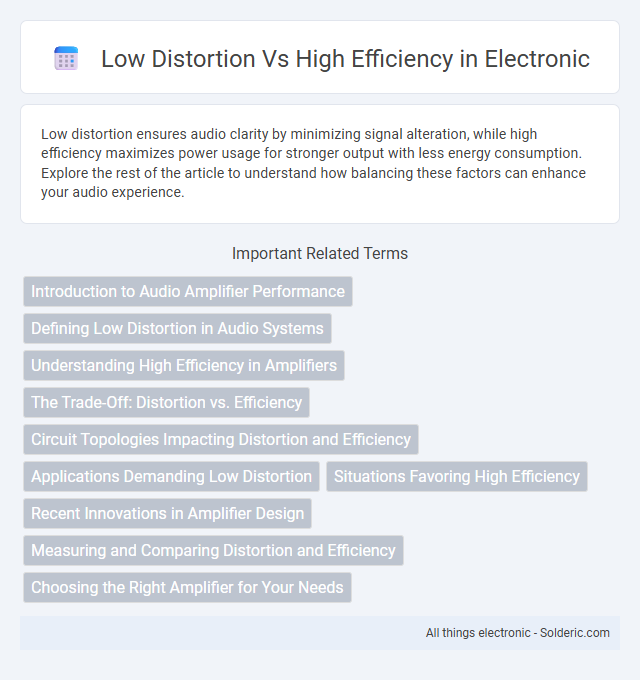Low distortion ensures audio clarity by minimizing signal alteration, while high efficiency maximizes power usage for stronger output with less energy consumption. Explore the rest of the article to understand how balancing these factors can enhance your audio experience.
Comparison Table
| Feature | Low Distortion | High Efficiency |
|---|---|---|
| Definition | Minimizes signal or image alteration to preserve original quality | Maximizes output performance with minimal resource use |
| Primary Goal | Accuracy and fidelity in reproduction | Speed and resource optimization |
| Typical Use Cases | High-quality audio/video, precision measurements | Energy-saving systems, fast processing tasks |
| Trade-offs | May require more resources, slower processing | May introduce errors or quality reduction |
| Common Technologies | High-fidelity amplifiers, lossless codecs | Compression algorithms, power-efficient devices |
Introduction to Audio Amplifier Performance
Low distortion in audio amplifiers ensures the output signal closely replicates the original input, minimizing harmonic and intermodulation distortions that degrade sound quality. High efficiency in amplifiers reduces power loss and heat generation, crucial for portable and high-power applications, often achieved through Class D or switching amplifier designs. Balancing low distortion and high efficiency is essential for optimal audio performance, influencing factors like signal fidelity, power consumption, and device longevity.
Defining Low Distortion in Audio Systems
Low distortion in audio systems refers to the minimal alteration or unwanted changes in the original sound signal during playback, ensuring the audio output remains true to its source. It is measured by Total Harmonic Distortion (THD) and Intermodulation Distortion (IMD), with lower percentages indicating cleaner sound reproduction. Maintaining low distortion is crucial for your audio experience to preserve clarity, detail, and accuracy without adding noise or artifacts.
Understanding High Efficiency in Amplifiers
High efficiency in amplifiers means converting more electrical energy into output signal power with minimal energy lost as heat, crucial for reducing power consumption and maintaining cooler device operation. You benefit from high-efficiency amplifiers in applications where extended battery life and energy savings are essential, such as in portable electronics and large sound systems. While low distortion emphasizes signal fidelity, high-efficiency designs like Class D amplifiers balance performance with reduced power waste for practical, high-performing audio solutions.
The Trade-Off: Distortion vs. Efficiency
Low distortion audio systems prioritize minimal signal alteration, preserving sound quality but often at the expense of energy efficiency and higher power consumption. High efficiency designs optimize power use and minimize heat generation, sacrificing some audio fidelity through increased distortion or reduced linearity. Balancing distortion and efficiency requires selecting components and architectures that align with specific application needs, such as Class A amplifiers for low distortion or Class D amplifiers for high efficiency.
Circuit Topologies Impacting Distortion and Efficiency
Circuit topologies such as Class A amplifiers prioritize low distortion by operating with a constant current, ensuring minimal signal clipping but at the expense of high power consumption and low efficiency. In contrast, Class D amplifiers achieve high efficiency through pulse-width modulation and switching mechanisms, though they often introduce more distortion due to switching noise and signal processing complexities. Bridging these trade-offs, Class AB amplifiers offer a balanced approach by combining elements of both Class A and Class B designs to moderate distortion levels while enhancing efficiency.
Applications Demanding Low Distortion
Applications demanding low distortion, such as high-fidelity audio systems and professional recording studios, prioritize maintaining signal purity to ensure accurate sound reproduction. In these environments, minimizing harmonic and intermodulation distortion preserves audio clarity and detail, making low distortion amplifiers essential despite potentially lower efficiency. You benefit from enhanced listening experiences where sound accuracy outweighs power consumption concerns.
Situations Favoring High Efficiency
High efficiency is crucial in battery-powered devices where conserving energy extends operational time, such as in smartphones and portable medical equipment. Power amplifiers operating in communication systems prioritize high efficiency to reduce heat generation and improve battery life without significantly sacrificing signal quality. Situations demanding prolonged device usage or minimal energy consumption inherently favor high efficiency over low distortion.
Recent Innovations in Amplifier Design
Recent innovations in amplifier design have significantly reduced distortion while maximizing efficiency through advanced feedback control and novel semiconductor materials, such as gallium nitride (GaN). These cutting-edge amplifiers maintain high fidelity audio reproduction and improved thermal management, enabling your sound system to deliver clear, powerful output without compromising energy use. Optimizing both low distortion and high efficiency ensures enhanced performance for demanding applications in consumer electronics and professional audio.
Measuring and Comparing Distortion and Efficiency
Measuring distortion involves analyzing waveform integrity through metrics like Total Harmonic Distortion (THD) and Intermodulation Distortion (IMD), which quantify deviations from the original signal. Efficiency is assessed by calculating the ratio of output power to input power, often expressed as a percentage, indicating how well a device converts energy without losses. Comparing low distortion and high efficiency requires balancing signal fidelity with power conservation, as improving one can impact the other in audio amplifiers and electronic components.
Choosing the Right Amplifier for Your Needs
Choosing the right amplifier depends on balancing low distortion and high efficiency to match your audio preferences and system requirements. Low distortion amplifiers deliver cleaner, more accurate sound reproduction, ideal for audiophiles seeking pristine audio quality. High efficiency amplifiers reduce power consumption and heat generation, making them suitable for portable setups and energy-conscious environments, allowing you to optimize your sound without compromise.
Low distortion vs High efficiency Infographic

 solderic.com
solderic.com